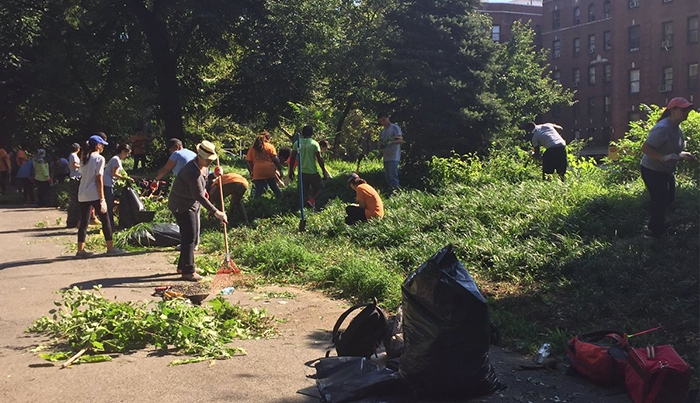Photo Courtesy of Dr. George Askew
According to NYC Chief Service Officer Paula Gavin, “Volunteerism and civic engagement are such a critical part of the fabric of New York City.”
By Forum Staff
Residents of the five boroughs are engaging in volunteerism at a rate (48 percent) that is more than three times higher than has been traditionally reported, and service continues to be a uniting force in New York, with residents seeking out opportunities to address issues shared by others who hail from similar backgrounds, NYC Service announced on Thursday as it released its “NYCivic Engagement: Neighborhood Volunteer Study & Plan” report.
“Volunteerism and civic engagement are such a critical part of the fabric of New York City, and we’ve seen this time and time again when our communities come together to support one another,” said NYC Chief Service Officer Paula Gavin. “NYC Service is proud to build on this strength through the Neighborhood Volunteer Study & Plan by shedding light on how New Yorkers engage at a neighborhood level and how our City can partner with communities to build, support, and strengthen neighborhood volunteer networks so we can continue to build a stronger and more inclusive city.”
NYC Service – in partnership with the Mayor’s Community Affairs Unit, the Mayor’s Public Engagement Unit, and Prof. John Mollenkopf of the CUNY Graduate Center – spent several months studying volunteerism and civic engagement, which included surveying more than 850 individuals and commissioning 14 focus groups in several neighborhoods in Western Queens (among them East Elmhurst, Jackson Heights, Sunnyside, and Woodside). The door-to-door survey included key questions asked on the national Current Population Survey as well as more detailed questions on civic engagement and social trust.
Key findings of the study include:
New Yorkers are engaging at high levels across many demographic groups through primarily localized opportunities
High levels of volunteering cut across almost all demographic groups surveyed
Respondents engaged in primarily localized opportunities, including those with their children’s schools or local organizations, focused on specific community issues. High levels of engagement were found with religious organizations (outside of attending worship services), particularly among black and Hispanic respondents
Personal interests and identity
drive volunteerism
Relating to a higher moral cause and responding to a specific community need were the strongest influences in activity
Respondents seek out opportunities that align with their community and interests
Volunteerism correlates with other forms of civic engagement, such as voting or attending community meetings
Residents face significant obstacles
to volunteering
Lack of time, by far the largest inhibitor keeping individuals from engaging in their community
Lack of knowledge of available volunteer opportunities
Lack of access to volunteer opportunities due to challenges like language barriers
“This one-of-a-kind effort reveals the contours of civic engagement in some of New York City’s most diverse and interesting neighborhoods – and shows their residents care about neighborhood issues and commit their time to taking care of them,” Prof. Mollenkopf added.

